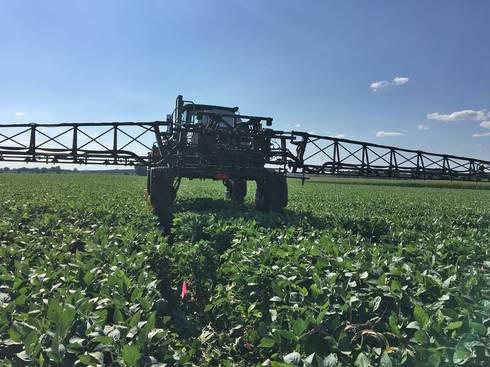December 26, 2018

Source: Michigan State University
We demonstrated a modest but significant soybean yield increase using a Prioxar fungicide spray at R3 in 2017. In 2018, we intended to boost yield further by combining the fungicide with a small dose of late season foliar nitrogen. A report in the 2017 Agronomy Journal publication reported that biological fixed nitrogen in root nodules and soil nitrogen typically provide enough nitrogen N for 55 to 60 bushels, but for high yields above 60 bushels, supplemental nitrogen may be needed to fill the last pods. This is because nodule activity decreases exponentially toward the end of the soybean plant lifecycle.
The objective was to increase the current soybean yield by 10 percent. The hypothesis is that soybean yield will be increased by improving overall plant health (disease control, leaf retention and photosynthetic duration). Priaxor is effective in controlling several soybean fungal diseases. The data would enable us to better predict and identify soil and plant conditions where a positive yield response can be expected.
This trial consisted of three treatments: T1, check (Grower Standard Practice with no foliar treatments; T2, foliar applied Prioxar at the rate of 8 fluid ounces per acre at R3; and T3, foliar applied Priaxor at 8 fluid ounces per acre tank mixed with 30 pounds nitrogen per acre (in the form of 28 percent nitrogen) at R3.
The trial was planted June 5, 2018. Treatments were replicated four times. The plots were 90-foot-wide field strips in 15-inch row spacing. The variety was Dairyland DSR 2400, a non-GMO. The planting population was 140,000 seeds per acre. Previous crop was corn and minimum tillage was used. Seed was inoculated prior to planting. The fungicide and nitrogen were foliar applied under ideal spraying conditions on Aug. 8. The plots were harvested Nov. 18.
This year, the planting date was delayed due to too much rain in May. Hence the R3 stage was reached much later than the usual time. We then encountered an extended period of drought in June and July. The crop benefited from plentiful rain in August. The harvesting was delayed because of excess rain and wet soil conditions in October and November.

The soybean yield differences were statistically significant p<0.5 (Table 1). Both the fungicide treated (T2) and fungicide plus nitrogen treated (T3) plots produced significantly higher yield compared to untreated (T1). However, foliar nitrogen did not stimulate a yield increase over and above the fungicide treatment. It turned out that fungicide plus nitrogen combination yield was slightly lower than the fungicide only plots. We observed a slight stunting/wilt like symptoms in the upper canopy in the fungicide plus nitrogen treatments following application. This was temporary and plants recovered quickly thereafter showing no phytotoxic effects. It is conceivable that foliar application of 30 pounds nitrogen in combination with the fungicide adversely effected soybeans potentially contributing to some yield loss.
The average crop yield in this field in the previous years is around 50 bushels per acre. So, the 2018 season in general was favorable for high soybean yield. This can be largely attributed to August rainfall. The increased yield due to the fungicide may be slightly above the break-even point, cost wise.
A point of interest was that there were no major disease symptoms in the foliage in the untreated and treated plots during the season. So, it is difficult to assess how the fungicide affected plant health and crop yield.
Michigan soybean farmers continue to show interest in using nutrients and fungicides to increase yield. The use of a small dose of nitrogen is not meant to indicate any major shift in Michigan State University nitrogen recommendations, rather a site-specific practice that could potentially close the prevailing yield gaps and boost local yields under certain conditions. So, there is merit for continuing on-farm research towards fine tuning practices that would contribute to more predictable and economic yield responses.
Special thanks to Trevor Kraus, Technical Service Rep, BASF, for contributing Priaxor for this study. Also thanks to Mike Staton and Michigan Soybean Promotion Committee Check-off and Martin Chilvers, MSU Extension Specialist for support and collaboration in this study.
This article was published by Michigan State University Extension. For more information, visit http://www.msue.msu.edu.
You May Also Like




